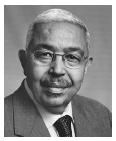CAPE VERDE
Pedro Verona Rodrigues Pires
President

(pronounced "PAY-drow veh-RONE-ah rod-REE-gez PAIR-ez")
"It will never be possible to build the future that we envision for our children without the active participation of the women of Cape Verde. The majority of Cape Verdean heads of households are women."
Cape Verde is a nation made up of ten islands and five islets. The archipelago nation is situated in the Atlantic Ocean approximately 500 km (311 mi) west of Dakar, Senegal. Sao Tiago (Santiago) is the largest island at 922 sq km (356 sq mi); it is also the location of the capital, Cidade de Praia. Mindelo, on the island of Sao Vicente, is the other main population center and the major port of the country. The total population was estimated at 408,760 in 2002. Cape Verde has a high birth rate with an average of 27.8 births per 1,000 population in 2002. Government efforts to curb population growth (0.85% per year in 2002) through family planning programs and legalization of abortion have not met with much success. Significant migration off the islands eases what would otherwise be an even greater burden. It is estimated that well over twice as many Cape Verdeans live outside the country (primarily in the United States, the Netherlands, Italy, and Portugal) as in the islands. The remittances sent home by these overseas Cape Verdeans are a significant source of income for the island population. Except for Sao Tiago, where the majority of the population is of African descent, most of the Cape Verdean people are of mixed African and European descent. The official language is Portuguese, but the vernacular is Crioulo, a mix of Portuguese with African vocabulary and syntax. Because of a concerted educational effort, illiteracy for those over 15 years of age averages only 28.4%. Life expectancy was 66 years for males and 73 years for females in 2002. That year, Cape Verde enjoyed one of the highest Human Development Index ratings for an African nation at 91. Approximately 96% of the population is Roman Catholic.
The islands are of volcanic formation and many are rugged, rocky, and deeply eroded. They are also very dry and experience periodic droughts of some severity. São Vicente has almost no potable water and relies on a desalination plant for the city of Mindelo. Due to poor soil, erosion, and frequent drought conditions, Cape Verde relies on international relief for most of its food supply and receives the second-highest level of aid per capita in the world. Eighty percent of this aid comes in the form of straight grants. Cape Verde continues to receive such substantial international support because the government has shown itself to be concerned with keeping its debt-servicing costs as low as possible. This international confidence has allowed the government to keep a high degree of control over the distribution of aid and thus has been able to direct its resources to projects in keeping with its national development plans. Cape Verde's chief exports are bananas, tuna, and lobsters. Its principal trading partners are Portugal, the Netherlands, Spain, Brazil, and the United States. The unit of currency is the escudo , pegged to the euro.
ADDRESS
Presidencia da Republica
Cidade de Praia
Santiago, Cape Verde
Comment about this article, ask questions, or add new information about this topic: